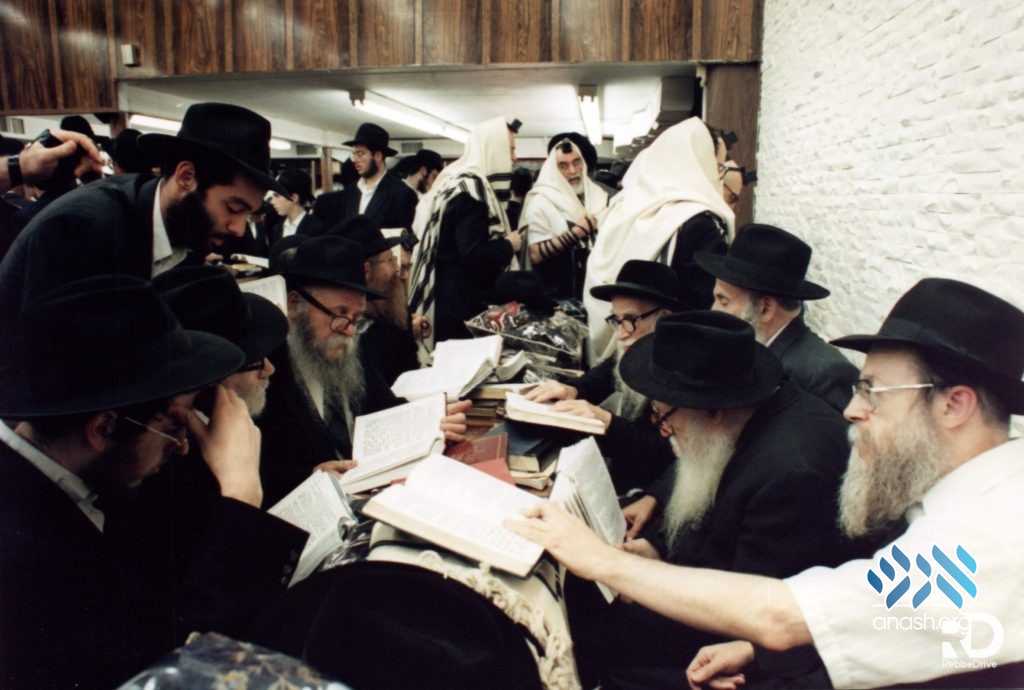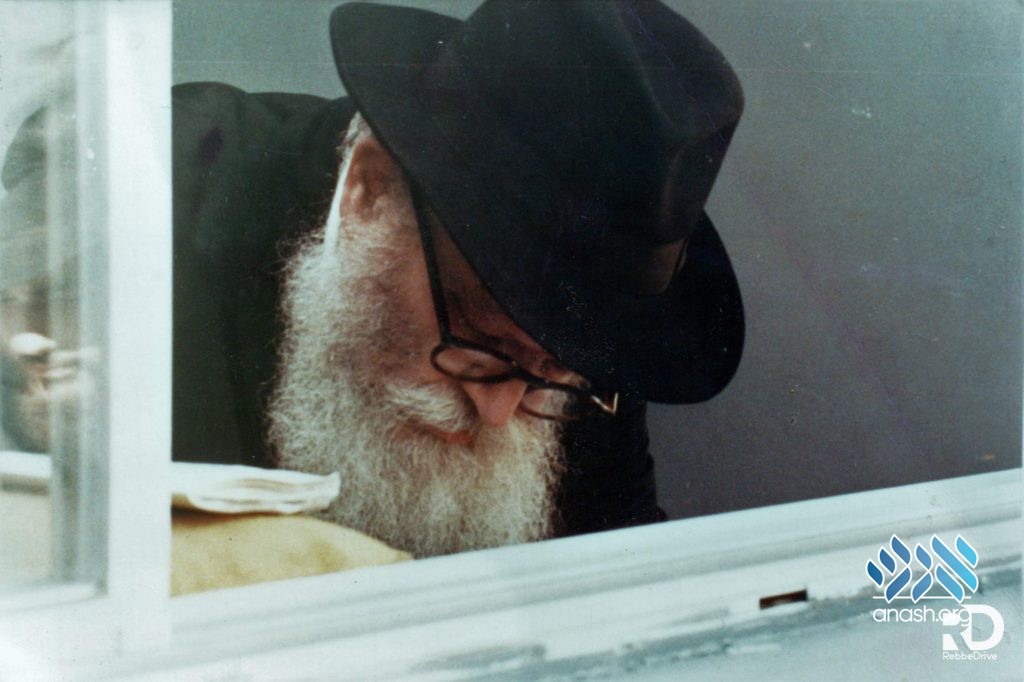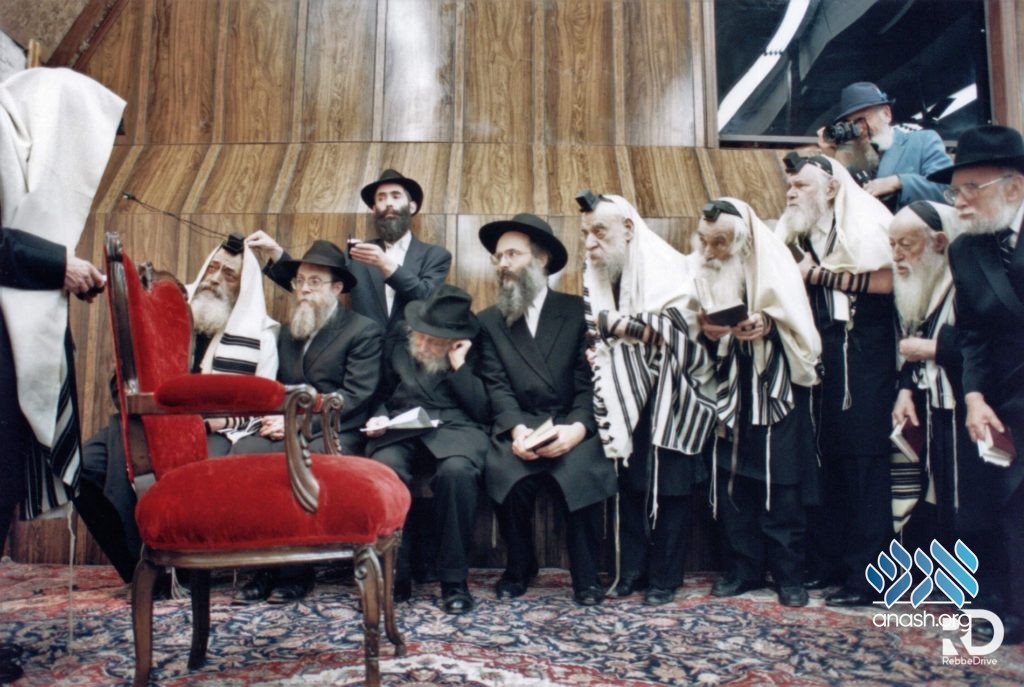The Avner Institute presents a compilation of powerful Rosh Hashana moments by the Rebbe as told by Rabbi Yossi Lew.
“Like a Lion’s Roar”
On the morning of Erev Rosh Hashanah, following Selichos, the Rebbe would go to the mikveh, then daven Sharcharis with the minyan. Morning service was 9:30, or 10:00 in the later years; in ’52 (1991), extremely late — close to noon.
Afterwards, a group of prominent rabbis and Chassidim assembled on benches around the Rebbe for hataras hanedarim, the Nullification of Vows. The Rebbe recited the prayer, as with everything else, in such a sweet way. Afterwards, he would wish those present that they be signed and sealed for a good new year, as well as bestow other blessings. In ’52 there was a whole sicha in which the Rebbe mentioned the verse “And you shall judge the congregation and rescue the congregation.” In retrospect, this verse was chilling.
After the Nullification of the Vows came the reception of pidyonot, the slips of paper containing requests for the New Year. The Rebbe stood at the door of his office building as each person entered from the side and exited upstairs. The lines stretched at least halfway down Eastern Parkway. Everyone was silent; most carried a book of Psalms, prayers, or Chassidic discourses, while some were simply lost in thought.
The lines moved quickly. Before you knew it, you were inside 770, climbing the stairs, into the lower heavens, and there was the Rebbe. The Rebbe’s holy face emitted an earnestness that was enough to keep you moving. Once you handed in your request, the Rebbe usually wished you a sealed good year. With that, you were out of the door, but in the Rebbe’s hands.
At the end of the line, the elders handed the Rebbe a general request on behalf of the whole community for a good year. The Rebbe usually replied with a short blessing —sometimes before leaving to the Ohel, his father-in-law’s burial place!
Rosh Hashanah “Look”
The Rebbe would usually leave for the Ohel in the afternoon, at around two. This was the one day the general populace was allowed there together with him.
One year, the Rebbe came to the cemetery in his regular leather shoes. Before entering, he removed them and walked the rest of the way, to the Ohel, in his socks. As the ground was covered with pebbles, it pained me to see the Rebbe grimace.
The Rebbe was busy there — on our behalf, of course. One year, he wept a very long time. He returned to 770 about a half hour or so before Yom Tov.
In certain years, when he left the upstairs shul after mincha, the New Year had already begun. He would come down for ma’ariv with a Rosh Hashanah “look”— very serious. Immediately he would sit and begin to recite the book of Psalms. After a few moments, if it wasn’t Friday night (or Motzei Shabbos, the following night), the Rebbe would rap lightly on the table to sing “Avinu Malkeinu.” This melody is stirring enough, but with the Rebbe at 770, it always sounded even more deep and special.
In later years, on the first night, the Rebbe would swing his arm after ma’ariv and say “Gut yontev” three times, after which he shouted: “May you be sealed and written for a good year!” Many people stayed on at 770, to pray more intensely.
“Before Whom we are Standing”
There was an unwritten rule in 770: If you were there by eight Rosh Hashanah morning, you can have your “fixed spot” for the shofar blowing. This was for all those around the bimah, the Torah reading area. I merited a place three rows back, right in the center, where I could see and hear the Rebbe blow shofar in a deep way.
Needless to say, none of us were “not there” at eight. Afterwards, many left for mivtzoim. By ten, when the Rebbe arrived, that place was packed.
The Rebbe entered holding his special prayerbook — of the saintly Kabbalist from Safed, the Ari Zal — and the shofar. His secretaries Rabbis Leibel Groner and Binyomin Klein followed, carrying three or four sacks of pidyonos. These would be placed on a small table right near the Rebbe.
By the time the Torah reading arrived, the crush towards to the central area was incredible. This is where and how the term “washing machine” was coined: after about the fifth row back, the rest of the rows would sway with incredible force. People were pushed out, or they fell or fainted out. For those circling the bimah, it was a crush you felt in your ribcage for hours, even days afterwards. Those standing at the tables around the bimah brought cushions, lest the metal of the tables cause some serious damage.
Right before the blessings, the unforgettable Chassid and caretaker Rabbi Moshe Pinchas Katz would pound on the bimah and announce: “Stand and remain in your places.” No one should stand on any benches or boxes, and everyone should allow everyone else to see. Each and every time he made that announcement, he would finish by saying: “Un men zol vissen vu m’shtait un far vemen men shtait—one should know where we are standing and before whom we are standing.”
There was a regular list of people who were called to the Torah reading: the Rashag [the Rebbe’s brother-in-law] was always the third. Distinguished Chassidim such as Reb Mendel Futerfas were also called. All these people would make their way to the bimah behind the Sefer Torah and stay there —often at the direct instruction of the Rebbe —throughout the shofar blowing. Yes, there was a crowd.
The Face of Yom Tov
On the first day, the Rebbe would be called up to the Torah for maftir. On the second, he came ahead to say Kaddish (for his mother-in-law). From about the second reading, efforts were made to form a line for the Rebbe to pass through a solid mass of people.
The Rebbe approached the bimah with his prayerbook and shofar, followed by his secretaries. At last he began the Haftorah. In earlier years he wept heavily, especially at the Haftorah on the first day.
Haftorah done, a hive of activity began. First, the Rebbe turned around and motioned for the sacks of requests to be placed at the far edge of the bimah. He then led the preliminary prayers to the shofar blowing. He lay three kerchiefs of different colors, on which the shofar would be placed. He then motioned to those holding the Torah scrolls to come close and stand on either side. Finally, he covered the entire bimah, including the stack of pidynos, with his tallis. All one could hear were the whirring of fans —sometimes, though, the soft tone of a melody.
The Rebbe could have remained under the tallis for even ten seconds, or a lot longer, a minute or two. When he emerged, a different face appeared — usually pale, but sometimes red. Many times, tears could be seen.
The Rebbe would raise the edge of the tallis to right below his eyes; a cry, like a lion’s roar, would emerge with the beginning words: “Lamnatzeach livnei keirach mizmor.” He threw the tallis back over the entire bimah, covering the pidyonos as well, and a loud hum followed throughout 770 as the congregation chanted the accompanying verses seven times. Once the place was again silent, the Rebbe held his tallis under his eyes and began “Min Hameitzar.” His eyes were brimmed with tears; often he wept in the middle of the verses as well.
He then motioned to Rabbi Mendel Tannenbaum – the reader and the one who blew the next hundred shofar notes — to stand right beside him.
The Rebbe then made the blessings. The “Amen” after those blessings still reverberates in my ears.
The Rebbe’s shofar blast was very long — usually three and a half shovorim. Sometimes it sounded more like four or more. The teruyos blasts were always amazing: they were not too fast, and sometimes sixty or seventy would be blown! The Rebbe’s holy face would turn red.
Between each set of blasts the Rebbe placed the shofar down and either threw the tallis over the bimah again, or at least move down while under the tallis. Afterwards, he sang the three following verses with such an amazing melody.
After returning to his place, the Rebbe usually held up his tallis, away from the face, and turn completely around, to the left, till the circle was completed. This is because it is supposedly good luck to look at the face of the shofar blower after the ceremony.
Storming the Gates
On the first day of Rosh Hashanah (if not Shabbos) was Tashlich. In earlier years the populace would walk a few blocks to recite this service at the lake in the Brooklyn Botanical Gardens. The Rebbe organized the Chassidic parade, which marched together down Eastern Parkway, singing songs. The area swelled with Jews, many non-observant, who came out to watch this spectacle.
In ’17 (1956), a major downpour happened that first day. As the hats the men wore those days were stained with black dye, they returned from the gardens with dye running all over their faces and shirts.
As a result of the rain, though, the gates were closed, since normally, who visits the gardens then? The Rebbe handed his prayer book over to Rabbi Yisroel Duchman, a”h, and began climbing the gate, then back down on the other side.
He signaled for everyone to climb — and everyone, young and old, climbed up! Some needed help, like the Rashag, but everyone made it over! “L’chatchilah Ariber!”—You should only climb higher!
After returning to 770, the Rebbe stood on a bench and gave out wine. As several people passed by, he felt their clothing to see if it was wet.
As the neighborhood changed in the Sixties, the Rebbe asked about making Tashlich outside of 770. They created a pond, after finding a well. And it’s there to this day.
“Phenomenal Revelation”
On the second day of Rosh Hashanah, before sunset, the Rebbe would farbreng. On years Rosh Hashanah fell on Thursday and Friday, the rabbis would not grant permission the ability to eat and drink after nightfall. The Rebbe, however, would still come to the farbrengen and wash for challah but not drink l’chayim past sunset.
At the farbrengen of ’84 (1983) the Rebbe actually encouraged everyone to do this. He stared at his watch two or three times, while prodding the congregation finish l’chaim. The Rebbe then said a whole sicha about l’chaim.
The question then: what to do with kos shel b’rocho, the wine he poured into everyone’s cup afterwards?
“I don’t want to distribute this Friday night,” the Rebbe once explained, since many had not yet made formal Kiddush. Therefore, following the next day’s farbrengen, on Shabbos Shuva, the Rebbe would stand up and distribute the wine and blessings.
What an incredible half hour this was! All the songs—“Sholosh Tenuoas, Ovinu Makeinu, The Kapelyah, Yemin Hashem, Lechatchilah Ariber, Niggun Hachonoh,” and “The Benuni”— moved the audience, who sang them deeply, while the Rebbe, with great earnestness shook his head in beat.
And then came the Rebbe’s niggun “Atoh Bechartonu.” It would burst forth in the only way the Rebbe’s niggun could. He usually bounced up and down with his head, and the entire building would vibrate intensely.
“Veshimchoh Hagodol, Hagodol Vehakodosh, Oleinu Koroso” . . . over and over again. What a climax, what a finish, what an experience!
Then came a most phenomenal revelation: now was the time G-d Himself should be doing His work below. The Rebbe began to sing the entire first part of “Atoh Bechartonu” from beginning to end! As soon as he finished “Oleinu Koroso” he rose up in dance for the next, joyous part of the niggun. This went on for a very long time.
In ’45 (1984), which was Friday, the Rebbe spoke about the virtue of wordless melodies. He then had everyone sing the famous melodies written by the previous Rebbes. At the next day’s farbrengen, the Rebbe instructed everyone to sing songs with words. When the congregation clamored to find these songs, the Rebbe said one without words should be sung.
Complete Revelation
The farbrengen itself was never too long. I do not believe any Rosh Hashanah farbrengen went past three hours. But there were quite a few really memorable moments:
One highlight that sticks out in my mind is the farbrengen of Erev Rosh Hashanah 5745 (1984). During a sicha [discourse] the Rebbe answered some questions of those who had delved into the topic discussed during the previous Shabbos farbrengen. The Rebbe revealed some personal information on how he prepared his discourses.
A number of times the Rebbe instructed us to sing “Avinu Malkeinu” at this farbrengen, and in the earlier years “Ki Vesimcha,” as an exit out of the old year. At the farbrengen of the third sicha of ’29 (1968) the Rebbe actually stood up to dance.
At the end of ’41 (1980) the Rebbe gave a sicha in Russian! My father went to Russia for that Rosh Hashanah, and I believe they told him there about it later!
There were things the Rebbe said at this farbrengen (and on the second day of Rosh Hashanah itself) which would be connected to the coming year, most of which would be understood only later. For example, at the end of ’41, he mentioned how the Tzemach Tzedek, the third Lubavitcher Rebbe, “would make paradkes” — affect things in the capital, S. Petersburg, all the way from the shtetl of Lubavitch!
On a year the Rebbe mentioned this, something significant would happen in the bigger world. Based on these thoughts the final day of the year, we could prepare ourselves for what lay ahead.
In ’24 (1963), for example, the Rebbe spoke with a great sorrow about the plight of the Soviet Jews. He then asked that everyone say l’chayim on their behalf. The Rebbe seemed to dance at this farbrengen more times than any other! Reb Mendel Futerfas was released that year; the miracle was complete.
May we all have a good sweet year! And most importantly, may we be renewed with the blasts of the Great Shofar of Moshiach on Rosh Hashanah!






Discussion
In keeping in line with the Rabbonim's policies for websites, we do not allow comments. However, our Rabbonim have approved of including input on articles of substance (Torah, history, memories etc.)
We appreciate your feedback. If you have any additional information to contribute to this article, it will be added below.